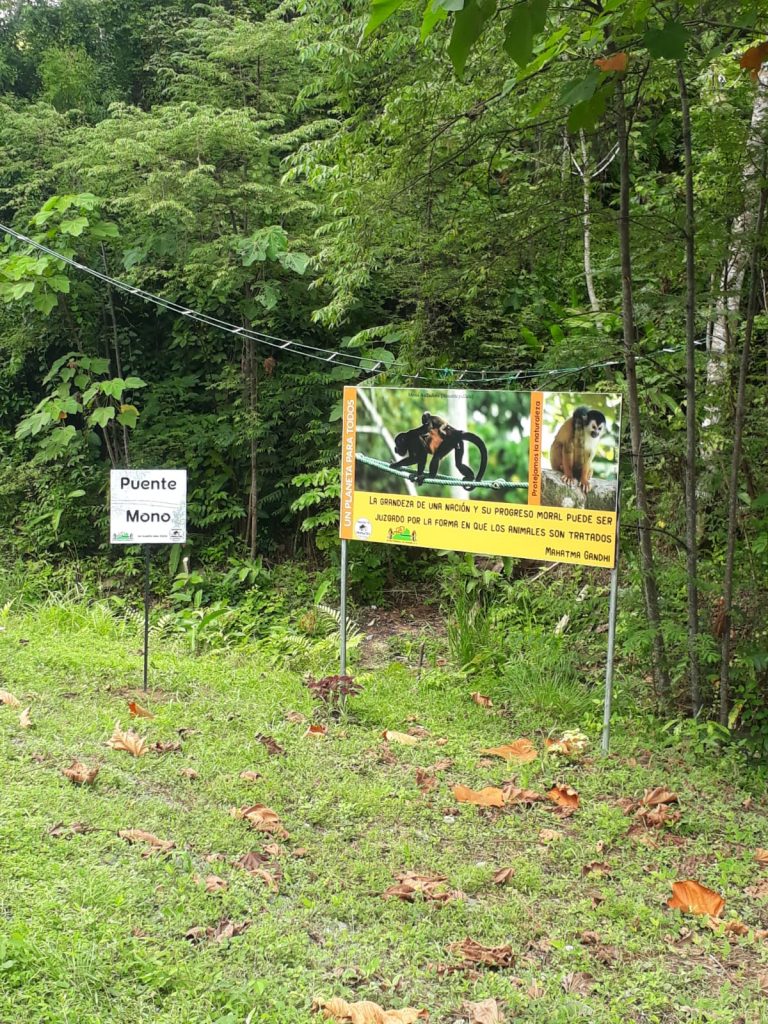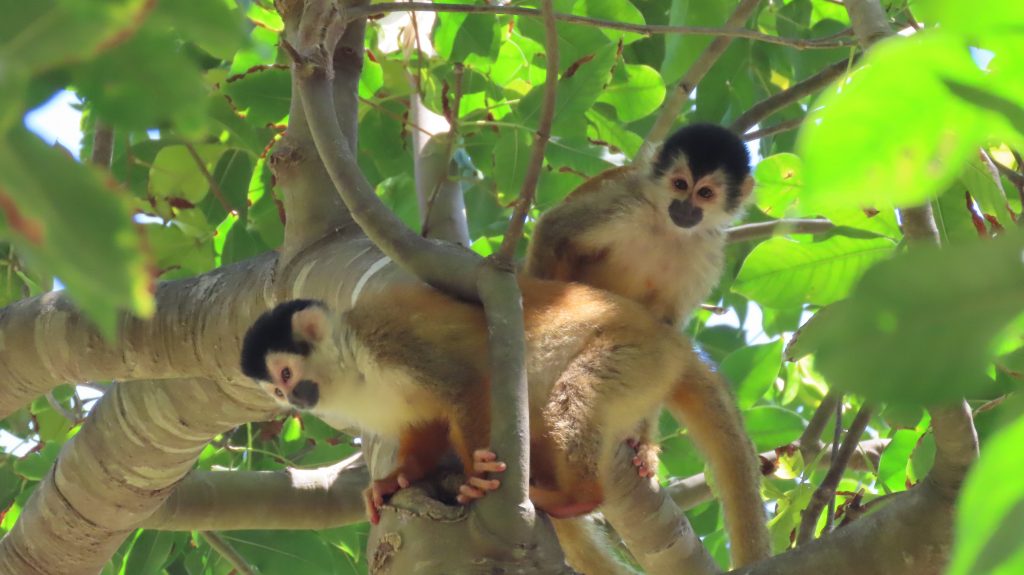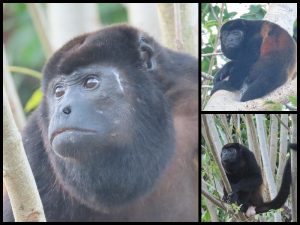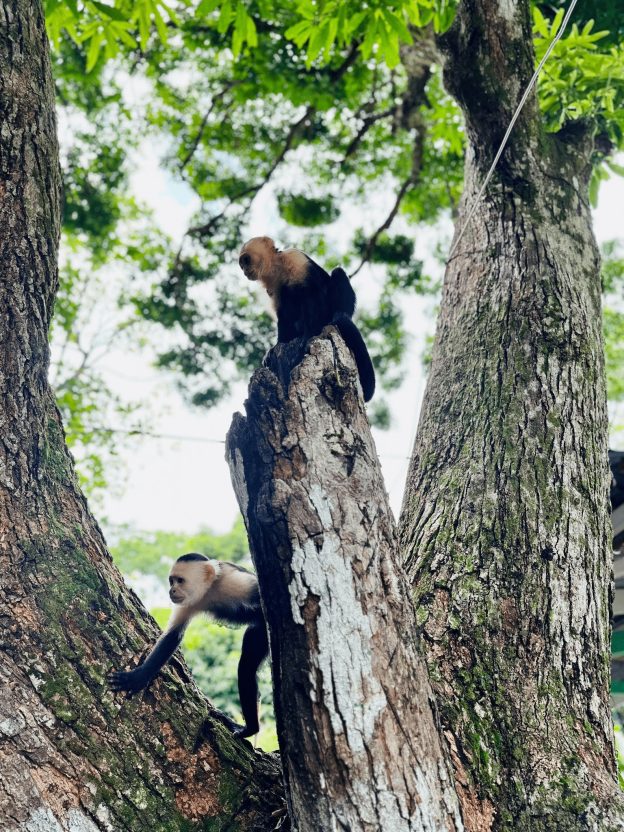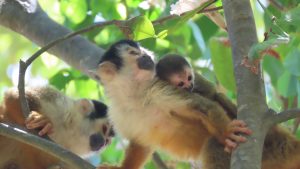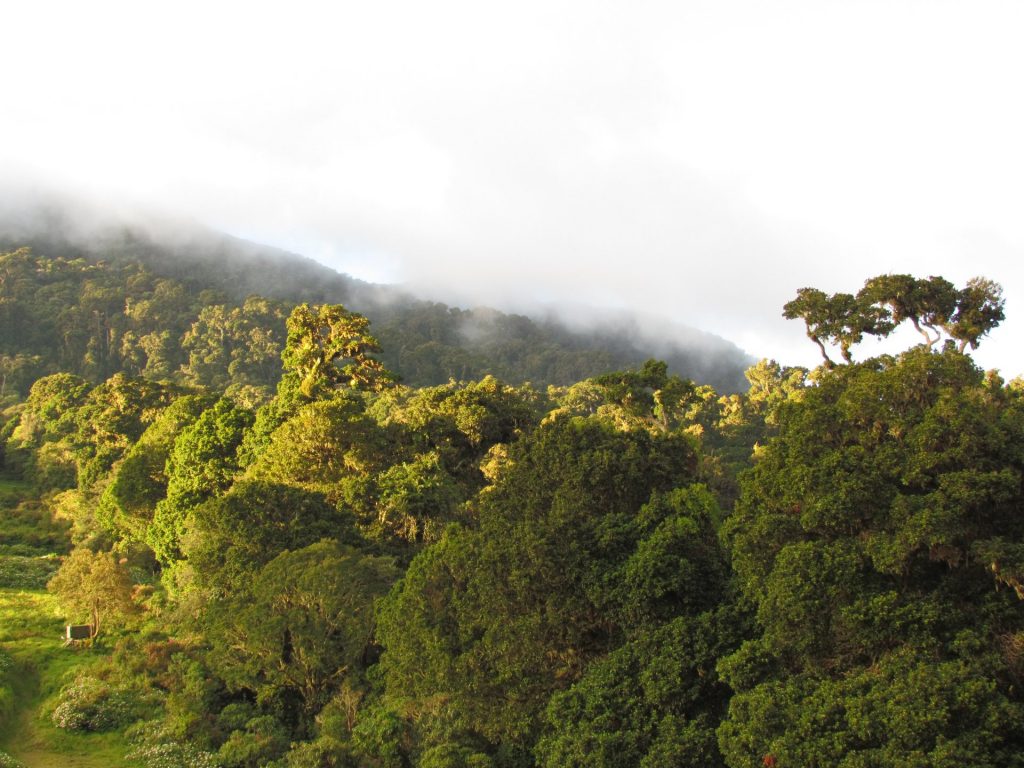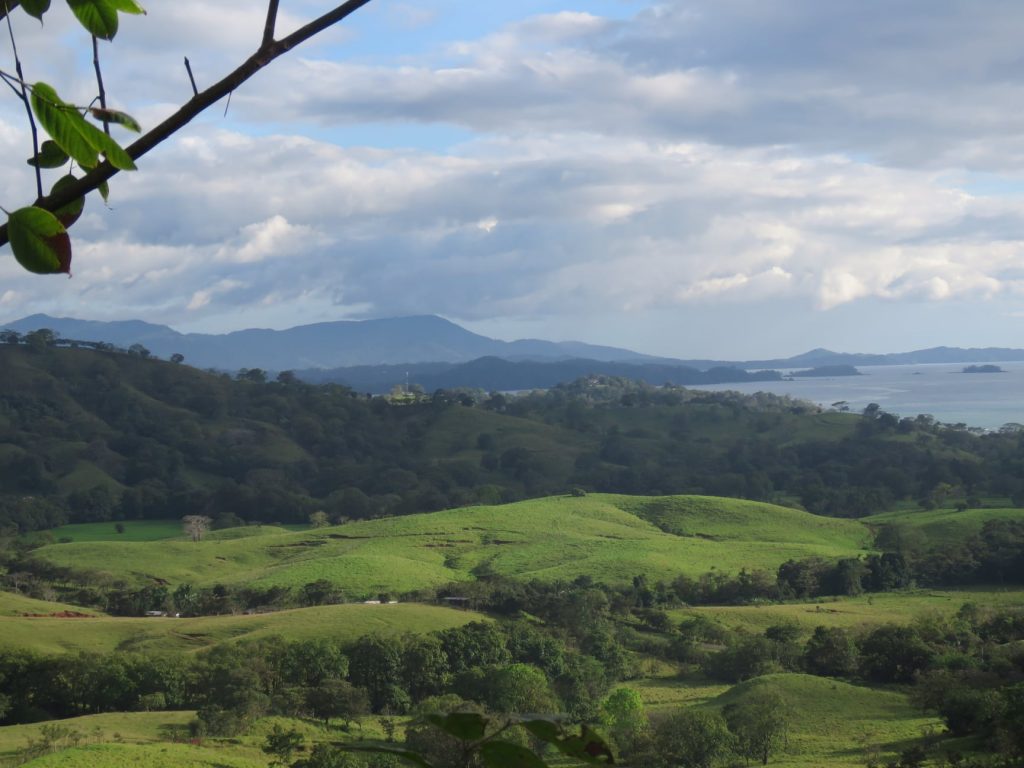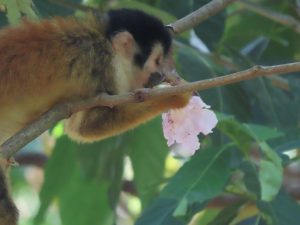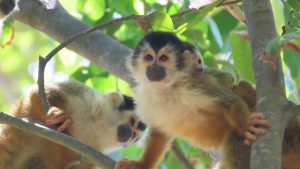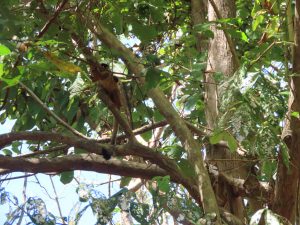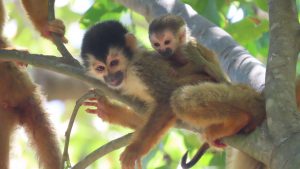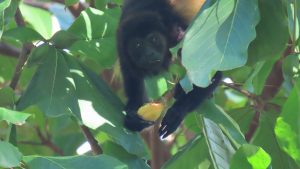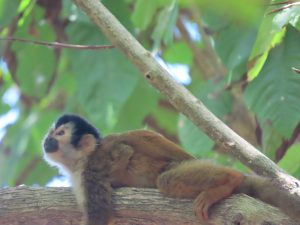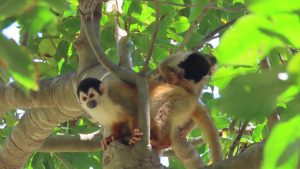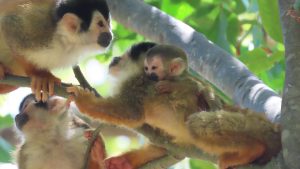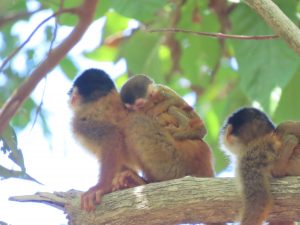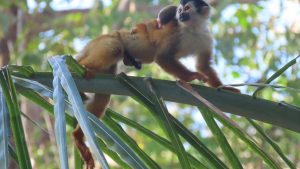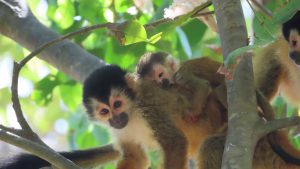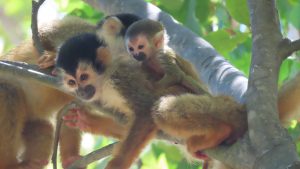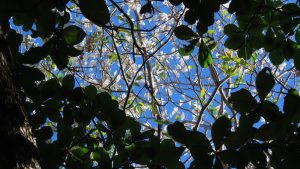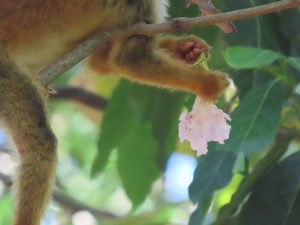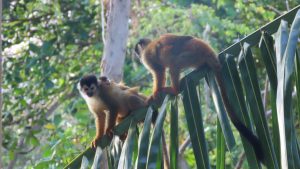COMPORTAMIENTO DE LOS MONOS ARAÑAS COLORADOS EN PANAMÁ
CLARENCE RAY CARPENTER
Journal of Mammalogy, Vol. 16, No. 3 (Ago., 1935), pp. 171-180
El propósito general de la investigación descrita en este trabajo fue complementar los conocimientos existentes sobre las actividades y relaciones sociales de los primates no humanos que viven en condiciones naturales. Los monos araña colorados (Ateles geoffroyi Kühl) fueron seleccionados como buenos sujetos para un estudio como el ya realizado sobre los monos aulladores (Carpenter, 1934). Se buscaron datos adecuados con vistas a un eventual trabajo comparativo sobre muchos tipos importantes de primates americanos y del Viejo Mundo.
Los datos de observación que son la base de este informe fueron recogidos durante dos campamentos en la región de Coto, en el oeste de Panamá. Se pasó un total de cuarenta y ocho días en el bosque. A veces fue posible hacer observaciones diarias y casi continuas de grupos o partes de grupos de monos araña. El primer campamento duró del 1 al 26 de junio de 1932, y el segundo del 18 de febrero al 12 de marzo de 1933. Queda mucho por hacer antes de que el trabajo sobre los monos araña esté completo. Por lo tanto, este es un informe preliminar.
El río La Vaca fluye a través de la región de Coto, poco cartografiada y escasamente poblada, que se encuentra en la frontera de Panamá y Costa Rica. A lo largo de este río, hacia el pie de monte, la selva es densa y está ocupada por una abundante vida silvestre que no es molestada casi en absoluto por los cazadores. Hay tapires, ciervos, jaguares, pumas, ocelotes, tairas, pecaríes, muchos mamíferos pequeños y una gran variedad de aves. Además, hay cinco tipos de monos: monos araña colorados (Ateles geoffroyi Kühl), muy abundantes, posiblemente más de doscientos en cada kilómetro cuadrado; monos capuchinos (Cebus capucinus), más limitados en número; los monos aulladores (Alouatta palliata palliata), poco numerosos y raramente vistos, pero ocasionalmente escuchados aullando en la distancia; los monos ardilla (Saimiri orstedii orstedii), bastante abundantes en las regiones de matorrales bajos; y los titíes (Oedipomidas geoffroyi), muy escasos. Fue en la región de esta densa e intacta población animal donde se estableció un campamento en 1932 y se volvió a ocupar en 1933.
El Dr. Herbert C. Clark, del Gorgas Memorial Institute, invitó al autor a unirse a una expedición a la región de Coto en 1932. El Dr. Clark inició, organizó y dirigió esa expedición. También ayudó a organizar y suministrar el equipo para el campamento del año siguiente. El autor pudo aprovechar las oportunidades que se le ofrecieron gracias a la aprobación y el patrocinio del profesor Robert M. Yerkes de los Laboratorios de Psicobiología Comparada de la Universidad de Yale. La investigación, además, fue posible gracias a una Beca Nacional de Investigación en Ciencias Biológicas y a una subvención adicional a la Universidad de Yale. El autor agradece los numerosos servicios prestados por la United Fruit Company y la Chiriqui Land Company a través de sus representantes, el Sr. Sterling Blair y el Sr. Kenneth Block.
La expedición a la región de Coto en 1932 fue una empresa de cooperación planificada principalmente para recolectar especímenes vivos y muertos de monos araña colorados y para observar sus actividades naturales y su vida en grupo. Los otros monos de la región eran de interés secundario. Además del autor, participaron en el proyecto los siguientes científicos: los doctores Robert Hegner, Herbert C. Clark, George B. Wislocki, Adolph H. Schultz y Carl M. Johnson. Sus temas de estudio fueron: Protozoos intestinales, patología, anatomía reproductiva y antropología física.
El autor regresó al campamento previamente establecido en febrero de 1933, acompañado por Mariana Evans Carpenter y dos nativos. Su propósito en la primera expedición había sido ganar experiencia en el campo junto con naturalistas de campo experimentados, para explorar las posibilidades de hacer un estudio exhaustivo de los monos araña colorados en su entorno natural, y comenzar dicho estudio si se encontraban condiciones favorables. La segunda expedición se llevó a cabo para complementar los datos adquiridos anteriormente, para atrapar una colonia de monos araña vivos para su uso en el laboratorio, para recoger una serie de tractos reproductivos de hembras para su estudio histológico y comparaciones, y finalmente para obtener registros fotográficos de movimiento y estáticos de las actividades de los monos araña.
PROCEDIMIENTO
El trabajo de observación se limitó a un sector del bosque cercano al campamento que se reservó para este fin. Se consideró que era más ventajoso concentrar el trabajo en un área pequeña y familiarizarse a fondo con la región y sus animales que trabajar en un gran territorio desconocido. No se permitió la caza en esta zona, porque la caza y la observación con éxito son incompatibles. El sector, que llegó a conocerse como el Cuadrante de Yale, se cartografió minuciosamente, sobre todo en lo que respecta a los árboles de alimentación, a los árboles en los que las tropas de monos araña pernoctaban y a los lugares en los que los grupos solían pasar largos períodos de tiempo descansando y jugando. Se trazó una red de caminos discretos por la zona y se cortaron sendas directas de árbol a árbol de alimentación y entre otros lugares de actividad.
Cuatro grandes grupos con un total de unos cien animales habitaban el cuadrante reservado del bosque, por lo que había muchos animales para observar. Normalmente, estos grupos de monos araña se despertaban al amanecer y comenzaban a desplazarse inmediatamente; se alimentaban, se desplazaban, descansaban y jugaban periódicamente durante el día. Al anochecer volvían a uno de los varios árboles habituales de «morada» y se instalaban para pasar la noche. A veces un grupo pasaba ocho o diez noches sucesivas en el mismo árbol o árboles. Los grupos de estos animales se desplazan con bastante rapidez, lo que dificulta su seguimiento a través del enmarañado bosque. Incluso cuando no son molestados, los grupos de monos araña se dispersan en un área considerable cuando viajan; y cuando son molestados por un observador, los grupos se dividen en un número de subgrupos que pueden separarse por espacios de hasta cuatrocientos o quinientos metros.
Fue necesario concentrarse principalmente con la observación de subgrupos, ya que no se podía seguir a grupos enteros durante largos periodos de tiempo. Se utilizaron dos planes de observación. Se alternaban con frecuencia: (1) Se observaban los animales desde una emboscada; y (2) se seguían de cerca los subgrupos durante el mayor tiempo posible en una jornada de trabajo. Era imposible, durante el periodo relativamente breve que se pasaba con los animales, acostumbrarlos a la presencia del observador.
Se disponía de muchos ejemplares muertos para examinarlos de cerca. En 1932 se recogieron doce crías y juveniles vivos, y dieciséis en 1933. La observación de cerca de estos animales vivos ayudó en gran medida a clasificar los monos vistos en la naturaleza con respecto al sexo y a la etapa de desarrollo. Mientras se trabajaba en regiones distintas a las reservadas para la observación del comportamiento, fue posible recoger hembras que se consideraban en estado de estro, para extraer los tractos reproductivos y así correlacionar la información anatómica y de comportamiento. También fue posible colectar individuos patológicos, e incluso subgrupos enteros, por ejemplo, un subgrupo de machos, para comprobar las observaciones de campo.
Se hicieron experimentos con métodos de captura de monos araña vivos. Se comprobó que los animales evitaban las cuerdas suspendidas con disparadores, así como otros tipos de trampas arbóreas. También se hicieron experimentos con gas lacrimógeno. Este método, aunque prometedor, resultó impracticable en las condiciones existentes y con la ayuda disponible. Se recurrió con éxito al método primitivo de disparar a la madre que llevaba una cría de tamaño deseable y luego recuperar la cría del animal muerto. Así, dos nativos bien entrenados podían recoger una media de dos monos jóvenes cada día.
REACCIONES DE LOS MONOS ARAÑA ANTE EL HOMBRE
Cuando se les acerca, estos animales suelen empezar a gruñir. A menudo se acercan al observador. El ladrido habitual, como el de un terrier, de gran excitación, puede cambiar a veces a un parloteo metálico que se repite con gran frecuencia. Cuando los machos, y a veces las hembras adultas, se acercan mucho, pueden gruñir de una manera sorprendentemente «viciosa». Normalmente, los animales se acercan a las partes terminales de las ramas, a menudo a menos de cuarenta o cincuenta pies del observador, y sacuden las ramas. Esto puede hacerse con las manos o con las extremidades posteriores; o pueden utilizarse tanto las manos como los pies mientras el animal cuelga de la cola.
Al mismo tiempo, y casi invariablemente, se produce un vigoroso rascado. Hay varios tipos de rascado. Las manos pueden usarse solas o juntas para rascar los lados, la espalda y los hombros opuestos a la mano que se está usando. Ocasionalmente ambas manos se utilizan para rascar un pie o ambos pies consecutivamente, o ambos pies pueden ser utilizados para rascar un brazo extendido. Junto con estas acciones, pueden producirse movimientos de carrera de las patas traseras mientras el animal cuelga suspendido de las manos o de la cola o de ambas juntas. Posiblemente se trate de movimientos de huida incipientes. Si está sentado, el animal puede balancearse de un lado a otro y vocalizar ruidosamente.
La rotura y caída de ramas es una parte conspicua de las reacciones de los monos araña ante el hombre. Con mucha frecuencia, estos animales rompen y dejan caer ramas con una referencia cercana al observador. Cualquier nativo experimentado le advertirá de esta fuente de posible peligro. A veces se rompen ramas verdes, pero la mayoría de las veces se rompen grandes ramas muertas que pesan hasta ocho o diez libras y se dejan caer hacia el observador. Uno puede imaginar el impacto de uno de estos misiles cuando se deja caer desde cuarenta o cincuenta pies sobre el suelo.
Este comportamiento no puede describirse como lanzamiento, aunque el animal puede hacer que el objeto caiga fuera de la perpendicular mediante un giro brusco de su cuerpo o un movimiento circular oscilante de su poderosa cola. La caída de objetos desde los árboles con referencia a una persona molesta puede considerarse, aparentemente, como una adaptación defensiva derivada del hábito más generalizado de sacudir las ramas. Una variación significativa de este hábito se produce cuando el animal rompe una rama y la mantiene durante un tiempo que varía desde unos segundos hasta medio minuto o más antes de dejarla caer, especialmente en situaciones en las que esta acción retardada hace que la rama caiga más cerca del observador que se acerca. En relación con este comportamiento de dejar caer objetos hacia el observador está la actividad común de soltar materia fecal y orina con referencia a él. Parece bastante claro que estos patrones de comportamiento pueden clasificarse como «actos instrumentales» llevados a cabo con referencia a objetivos defensivos particulares. Las reacciones de los monos araña ante el hombre muestran tres variantes claramente diferenciadas:
- Las reacciones agresivas, de acercamiento, de «farol», son las más frecuentes. Casi siempre los animales muestran este tipo de reacción cuando se les aproxima por primera vez y durante un breve tiempo después.
- Tras la reacción inicial, durante la cual aumenta la excitación de los animales, se muestran reacciones de huida. Durante estas reacciones, el grupo se divide en varios subgrupos.
- Los animales que han sido cazados y disparados pueden permanecer perfectamente quietos y parcialmente ocultos cuando se les acerca. Este tipo de reacción de defensa es muy eficaz para hacer pasar por alto a los animales. En general, los monos araña se comportan con el hombre como lo harían con un enemigo; es algo que hay que alejar o de lo que hay que huir.
ALIMENTACIÓN Y ACTIVIDAD ALIMENTICIA
Los monos araña colorados han sido clasificados correctamente como frugívoros. Se estima que alrededor del 90% de su comida consiste en frutas o frutos secos. Los animales pueden vivir durante periodos de tiempo considerables sólo con uno o dos tipos de fruta que estén en temporada. En junio de 1932, el «bogamani» o nuez moscada silvestre constituía una parte muy importante de su dieta; este fruto seco se come por la masa de arilos colorados que hay debajo de la gruesa cáscara.
En el estómago y los intestinos de un mono araña adulto pueden encontrarse hasta noventa granos, que son tan grandes como una nuez de nogal pequeña y que se tragan enteros. La «berba» y la «berbacilla», nueces parecidas a los frijoles que se encuentran en abundancia en los bosques de la región de Coto, eran también de gran importancia como alimento para los monos. Estas nueces son evidentemente ricas en valor nutritivo, porque los monos estaban excesivamente gordos mientras se alimentaban de ellas. En febrero de 1933, cuando sólo había unas pocas berbacillas, los animales parecían mucho menos alimentados que en junio del año anterior, cuando los especímenes recogidos eran muy gordos. En febrero de 1933, comían «higo», «higuerón» (higos silvestres), «bogamani», unas pocas «berbacilla» que maduraron temprano, «sandi», «guayaba», «caimito» y varias frutas que no fueron identificadas. Los siguientes árboles, nombrados según Standley (1933), son algunas de las fuentes más importantes de alimento para los monos araña: Ficus costaricana, Ficus glabrata, Helicostylis latifolia, Virola panamensis, Virola warburgii, Persea americana, Licania platypus, Inga edulis, Inga goldmanii, Inga spectabilis, Dipteryx panamensis, Anacardium excelsum, Anacardium occidentale, Spondias mombin, Rheedia madruno, Gustavia superba, Psidium guayava, Chrysophyllum cainito.
Se sabe poco sobre la alimentación del mono araña, aparte de las frutas. Los animales pueden ser vistos a veces buscando entre las hojas, bajo la corteza y en las extremidades muertas, aparentemente en busca de larvas e insectos. No se han encontrado pruebas que indiquen que coman huevos de pájaros o crías de los nidos. Consumen pequeñas cantidades de brotes y flores, pero éstas constituyen una parte insignificante de su dieta.
Los monos araña comienzan a alimentarse poco después del amanecer. El periodo más activo de alimentación se produce entre el amanecer y las 10 horas aproximadamente; a este periodo de alimentación intensa le sigue uno de descanso comparativo para los adultos y de juego para los jóvenes. La alimentación por la tarde es menos activa y más esporádica que la de la mañana. El forrajeo puede continuar hasta el anochecer.
LOCOMOCIÓN
La locomoción de los monos araña está más desarrollada hacia el tipo ortógrado que en otros platirrinos. Los movimientos braquiales de estos monos se aproximan a la forma de locomoción arbórea característica de los gibones. Normalmente, los monos araña se desplazan a lo largo de las superficies superiores de las extremidades, utilizando los manos y pies y llevando la cola arqueada sobre la espalda. La braquiación se produce principalmente al pasar de un soporte a otro. También en este momento, la poderosa cola entra en juego como apéndice de suspensión. Durante estos movimientos, las manos, los brazos y la cola se utilizan para hacer contacto con los soportes. Los monos araña muestran una fuerte tendencia a mantener la cabeza hacia arriba; por lo tanto, cuando descienden por una rama perpendicular, una liana o el tronco de un árbol, van hacia atrás en lugar de ir con la cabeza por delante como los aulladores. Al pasar por una rama horizontal, las largas manos de cuatro dedos se vuelven hacia fuera sobre el soporte; durante la braquiación, la mano se convierte en un eficaz gancho.
Frecuentemente realizan largos saltos hacia fuera y hacia abajo, cubriendo a veces más de treinta pies. Mientras salta, el animal extiende todos sus apéndices, aumentando así tanto la resistencia del aire como la posibilidad de hacer contacto con los objetos hacia los que salta. Varias veces se ha visto a los animales soltar todas las sujeciones y caer directamente hacia abajo durante seis o siete metros hasta las ramas inferiores o las copas de los árboles.
La velocidad media de locomoción es aproximadamente la de un hombre caminando a toda velocidad. En general, muestran una gran variedad de formas y velocidades de actividad locomotora. Sus movimientos son mucho más flexibles que los de los aulladores.
TERRITORIALIDAD Y NOMADISMO
Los grupos de monos araña son seminómadas, es decir, cada grupo habita una zona del bosque que, aunque bastante definida, puede solapar el territorio de otros grupos. Dentro de este territorio, deambulan con sus actividades centradas en la comida y en los árboles de estancia. Sin duda, se producen cambios en el área de distribución territorial, pero aparentemente el cambio es lento. En junio de 1932, había, en la zona reservada para el trabajo de observación, un clan que podía ser identificado de un día para otro con considerable certeza. Casi todas las noches este grupo dormía muy cerca del campamento en los árboles del otro lado del río. Durante ocho noches sucesivas los animales volvieron al mismo grupo de árboles de «níspero». A lo largo del día, el grupo viajaba, en general, por las mismas rutas de un árbol de comida a otro y hacia y desde lugares favorables en el bosque profundo donde se producía la «siesta» del mediodía. Otros grupos se situaban regularmente en sus zonas particulares. Los cazadores experimentados conocen y aprovechan el hecho de que los grupos tienden a habitar zonas especiales.
Poco se sabe de los factores que regulan los límites y el desplazamiento de los territorios de los distintos grupos. Cabe suponer, sin embargo, que influyen el tamaño del grupo y la disponibilidad de alimentos y de árboles favorables en los que jugar, descansar y pasar la noche. La competencia de los grupos en regiones adyacentes también sería significativa. Cabría esperar que los cambios en el área de distribución territorial se produjeran coincidiendo con las variaciones estacionales del suministro de alimentos.
Parece razonable suponer que un grupo se adapta a una zona concreta en parte por la facilidad que se establece a través de la alimentación, la asociación constante, el descanso, el juego y otras actividades diarias normales. Pronto se aprende la ubicación de los árboles de comida, de las rutas de viaje arbóreas y de los lugares favorables para otros tipos de actividad. Entonces funcionan como «metas» atractivas.
ORGANIZACIÓN DE LOS GRUPOS DE MONOS ARAÑA
Este estudio preliminar indica que los monos araña tienen una forma de organización grupal que difiere de la descrita anteriormente para los monos aulladores (Carpenter, 1934).
Típicamente, un observador encuentra a los monos araña en pequeños grupos. Estos pueden consistir en (a) una hembra y una o más crías, (b) un número de hembras con sus respectivas crías, (c) uno o más machos y muchas más hembras con sus crías, o (d) sólo machos. Si se siguen estas pequeñas agrupaciones durante un día, se descubrirá que acaban uniéndose a otras en diversas combinaciones. Las sub-agrupaciones que se observan por primera vez pueden pertenecer a una agrupación mayor que contiene hasta cuarenta individuos. Para invertir la descripción, si el grupo grande se encuentra a primera hora de la mañana y se observa de cerca, se puede ver que se divide en muchas agrupaciones más pequeñas que se separan entre sí a distancias variables y durante diferentes períodos de tiempo durante el día. Las divisiones del grupo mayor o sobregrupo se mantendrán más o menos en contacto entre sí por medio de vocalizaciones que se intercambian entre ellas. Los individuos que componen los subgrupos suelen permanecer a la vista unos de otros.
La tabla I muestra la composición de 19 subgrupos que son selecciones aleatorias de tipos observados en muchos clanes y registrados en las notas de campo. La variabilidad de las agrupaciones en cuanto a número y composición y la proporción de hembras adultas respecto a los machos adultos es especialmente digna de consideración. Además de las agrupaciones que se detallan en la tabla, se observaron otras siete sub-agrupaciones que contenían sólo machos adultos sin hembras ni crías. Estas sub-agrupaciones de machos constituyen una característica distintiva de la organización de las sociedades de monos araña.
Cuadro I
Subgrupos de monos arañas
|
No.
|
Machos
|
Hembras
|
Madres
|
Infantes1
|
|
Juveniles2
|
|
Total
|
|
|
|
|
No. 1
|
No. 2
|
No. 1
|
No. 2
|
|
|
1
|
|
|
1
|
|
1
|
|
1
|
3
|
|
2
|
1
|
1
|
|
|
|
1
|
|
3
|
|
3
|
3
|
1
|
1
|
|
1
|
|
|
6
|
|
4
|
2
|
3
|
|
|
|
|
1
|
6
|
|
5
|
3
|
1
|
1
|
|
1
|
1
|
|
7
|
|
6
|
|
3
|
1
|
|
1
|
1
|
1
|
7
|
|
7
|
5
|
1
|
|
|
|
1
|
|
7
|
|
8
|
1
|
6
|
|
|
|
|
1
|
8
|
|
9
|
1
|
2
|
1
|
1
|
|
3
|
|
8
|
|
10
|
|
2
|
3
|
1
|
2
|
|
|
8
|
|
11
|
1
|
4
|
1
|
|
1
|
1
|
2
|
10
|
|
12
|
3
|
4
|
|
|
|
1
|
2
|
10
|
|
13
|
7
|
2
|
|
|
|
|
1
|
10
|
|
14
|
1
|
4
|
2
|
|
2
|
1
|
1
|
11
|
|
15
|
2
|
3
|
2
|
|
2
|
2
|
1
|
12
|
|
16
|
5
|
4
|
3
|
|
3
|
|
|
15
|
|
17
|
2
|
5
|
2
|
|
2
|
3
|
2
|
16
|
|
18
|
5
|
4
|
2
|
|
2
|
3
|
1
|
17
|
|
19
|
4
|
4
|
2
|
|
2
|
3
|
2
|
17
|
|
46
|
54
|
22
|
2
|
20
|
21
|
16
|
181
|
1 Las crías son aquellas que están en la fase de coloración oscura y dependen principalmente de sus madres. Las crías clasificadas como número 1 son llevadas sobre el vientre o el costado de la madre, los clasificados como número 2 son llevados en la espalda de la madre.
2 Los juveniles son aquellas crías que son semi-independientes de sus madres pero están estrechamente asociados a ellas en subgrupos. Los juveniles número 1 y número 2 se diferencian en función del tamaño y de su relación con la madre.
Un estudio de las subagrupaciones temporales de los monos araña parece justificar su clasificación en tres categorías: (a) subgrupos de machos, (b) subgrupos de hembras (excluyendo las crías que se encuentran con ellas), y (c) subgrupos mixtos. Los tres tipos de subgrupos suelen encontrarse, según los datos disponibles, en cada grupo o asociación grande y relativamente estable.
Con tres excepciones, las sub-agrupaciones que figuran en el cuadro I contienen tanto machos como hembras. Las sub-agrupaciones 7, 13, 16 y 18 pueden considerarse compuestas en el sentido de que cada una de ellas contiene sub-agrupaciones masculinas que se movieron bastante cerca de los otros individuos. La primera subagrupación (nº 1) de la tabla está formada por una madre y un bebé (todavía en fase de coloración oscura) que ella lleva sobre su vientre, y un juvenil semi-independiente. De las dieciséis sub-agrupaciones que contienen machos, una tiene igual número de machos y hembras adultos, cuatro tienen más machos que hembras (estos recuentos incluyen las sub-agrupaciones exclusivamente masculinas) y once tienen más hembras adultas que machos. Por el momento, los datos son demasiado limitados para permitir un tratamiento estadístico de las agrupaciones y es imposible determinar las tendencias centrales de agrupación y la proporción socionómica de sexos característica (proporción de machos y hembras que viven dentro de los grupos).
El tamaño de las agrupaciones de machos oscila entre tres y diez individuos; dos sub-grupos tienen tres, dos tienen cinco y en los demás hay cuatro, siete y diez machos adultos. Se recogieron todos los animales que formaban varias de estas agrupaciones para mostrar con precisión qué tipos de individuos las componían. A. H. Schultz y el autor, a juzgar por la dentición y el desarrollo físico, han llegado a la conclusión de que los miembros de estos subgrupos tienen una edad que va desde la edad adulta temprana hasta la senilidad. Algunos de los conjuntos de dientes eran perfectos y bien desarrollados, otros eran «jóvenes», mientras que otros eran «viejos». Estos resultados se oponen a la teoría de que todos los machos que viven en subgrupos unisexuales o como individuos «solitarios» son tan viejos o débiles que no pueden hacer frente a la competencia dentro del grupo principal.
Las sub-agrupaciones que se han descrito se asocian en diversas combinaciones para constituir la sociedad típica de los monos araña. El número total de animales en un grupo principal en particular fue aprendido después de un estudio intensivo y después de varias oportunidades afortunadas de observar a todo el clan cuando entraba o salía de los árboles de morada. En febrero de 1933, el grupo contenía treinta y tres animales de todas las clases. Había ocho machos adultos, quince hembras adultas (cuatro de las cuales llevaban crías) y seis juveniles semi-independientes. Durante la última semana del mismo mes, este gran grupo se encontró repetidamente dividido en los siguientes subgrupos más estrechamente asociados:
- un subgrupo de machos de tres bien maduros y un macho inmaduro,
- un subgrupo de cuatro madres con sus crías, más cuatro hembras, cinco juveniles y un macho,
- un subgrupo de seis hembras, un juvenil y un macho adulto, y
- un subgrupo de dos hembras adultas, un macho adulto y un juvenil. Todo lo que se ha podido saber sobre las agrupaciones de otros clanes corrobora la suposición de que la descrita es bastante típica de los monos araña. Se necesita información adicional para dar el rango de variabilidad en este tipo de agrupación de primates.
Los datos disponibles no permiten hacer generalizaciones en cuanto a la proporción sexual socionómica en los grupos de monos araña. Los datos que tenemos indican fuertemente que, incluso incluyendo a los machos de los subgrupos unisexuales, hay más hembras adultas en los grupos que machos adultos. Esto es comparable con la condición encontrada en los monos aulladores (Carpenter, 1934). Wislocki (1930, p. 177) y Schultz, mediante la recolección aleatoria de animales, encontraron «una gran preponderancia de hembras en los monos araña y aulladores».
COMPORTAMIENTO REPRODUCTIVO
No se observó cópula en los monos araña en libertad, pero sí patrones de comportamiento sexual secundario.
Estos consistían en que el macho manipulaba el clítoris muy desarrollado de la hembra, la abrazaba, la acariciaba y vocalizaba para ella. Se han reunido considerables pruebas cualitativas que indican que la hembra tiene un período de celo bastante definido. A veces, las hembras pueden ser observadas inusualmente asociadas con uno o más machos. En dos ocasiones se colectaron hembras después de predecir, por su comportamiento, que estaban en celo. Una de las hembras estaba asociada a un solo macho y la otra a varios machos de una subagrupación mixta. En ambas hembras se encontraron tapones vaginales recién formados. Las paredes y las luces de las vaginas estaban muy agrandadas en comparación con las de las hembras que amamantan a sus crías.
Los monos araña en la naturaleza no tienen una estación de cría definida. En junio de 1932, y en febrero y marzo de 1933, se observaron todos los tamaños de animales infantes y juveniles, y se examinaron etapas representativas de todo el desarrollo de los embriones. Las conclusiones a las que llegaron Wislocki (1930) y Schultz es que estos animales no tienen temporada de reproducción fija, y las mismas opiniones expresadas por otros naturalistas, se ven confirmadas por las observaciones realizadas durante este estudio. No obstante, sigue existiendo la posibilidad de que haya una fluctuación considerable en el número de crías nacidas durante las diferentes partes del año.
RELACIONES DE LAS MADRES CON SUS CRÍAS
Durante un corto periodo de tiempo, posiblemente no más de un mes, una cría de mono araña es llevada en el vientre de su madre, y después de este intervalo se monta en la espalda de la madre en la región sacra y lumbar. Durante la locomoción de la hembra, la cola de la cría se enrolla alrededor de la de la madre cerca de su base. Los pies de la cría se agarran a los flancos de la madre y las manos se agarran al pelo de los costados de la madre.
Los monos araña jóvenes pasan por una fase de color negro durante aproximadamente los primeros seis meses de su vida, como se ha determinado a partir de un especimen en cautiverio. Después de esto, comienzan a tomar la coloración rojiza del adulto; esta fase de color se desarrolla completamente cuando los animales tienen unos diez meses de edad. Durante la fase de coloración negra, las crías dependen casi por completo de sus madres. Rara vez se les ve viajar solos durante la progresión del clan, y suelen encontrarse cerca de la madre mientras ésta descansa. Estas crías se clasifican como infantes en la Tabla I. El periodo de «dependencia infantil» en los monos araña es aparentemente mucho más largo que en los aulladores o los capuchinos. Los monos araña jóvenes dependen en gran medida de sus madres hasta que están en la fase de coloración rojiza, es decir, hasta que tienen unos diez meses de edad. Entonces pasan gradualmente de un período de dependencia a uno de independencia.
Se colectaron 16 crías y algunas de las más viejas de las capturadas estaban en el periodo de destete; otras estaban en la primera parte de la fase de coloración rojiza. El peso de estos animales oscilaba entre 768 y 2270 gramos. La media fue de 1579 ± 486 gramos. Las crías más grandes rara vez son llevadas por sus madres. Un ejemplar en cautividad que pesaba 2000 gramos tenía aproximadamente doce meses de edad. Los mayores de los monos capturados acababan de perder sus dientes incisivos permanentes, lo que se comprueba con el hecho de que un animal joven criado en cautividad perdió sus incisivos inferiores cuando tenía entre once y trece meses de edad. Cuando tenía quince meses, los cuatro incisivos estaban bastante desarrollados.
Las hembras de mono araña parecen ser más cuidadosas con sus crías que las hembras aulladoras. Se ha visto a los monos araña recorrer las copas de varios árboles, coger a sus crías, ponérselas en la espalda y llevárselas. A veces, las hembras se comportan como si protegieran a sus crías de otros monos o de un observador o cazador humano. Al igual que los aulladores, los monos araña ayudan a sus crías semi-independientes a atravesar lugares difíciles en los caminos arbóreos. Esto suele hacerse juntando las lianas o ramas separadas sobre las que hay que cruzar. A veces hay periodos de retraso de cuarenta o cincuenta segundos entre el momento en que la hembra junta los soportes y la cría hace el cruce. En otras ocasiones, las hembras toman a los jóvenes sobre sus espaldas, los llevan a través del difícil paso y luego los dejan al otro lado. Lo más insólito es la observación de una hembra de mono araña que sostenía una liana cerca del tronco de un árbol mientras cinco crías, que de otra manera no habrían podido cruzar, pasaban de la liana al árbol.
ACICALAMIENTO Y JUEGO
Se han observado algunos casos de acicalamiento en monos araña en la naturaleza. Esta forma de actividad se daba sobre todo entre las hembras y sus crías. Por lo general, las hembras buscaban en el pelo de sus crías, por lo que se pudo comprobar, y poner sus bocas en el pelo o la piel de los animales jóvenes. Las hembras realizaban largos movimientos descendentes de sus manos sobre las crías. Movimientos más ajustados se mostraban cuando un animal separaba el pelo y buscaba sobre la piel de un asociado. En los jardines zoológicos, se ha visto a los monos araña exploran el pelo y se quitan partículas entre ellos de forma similar al comportamiento de acicalamiento de los macacos. Aparentemente, esta actividad es más prominente en los capuchinos que en los monos araña. Rara vez se observa en los aulladores.
Los monos araña jóvenes muestran una variedad relativamente grande de patrones de juego. Entre los animales adultos hay poco o ningún comportamiento que pueda interpretarse como juego. Los patrones individuales de juego consisten en correr, saltar de una rama a otra o quedarse quieto y saltar, balancearse de una rama mediante una o varias combinaciones posibles de los apéndices y jugar con palos u otros objetos. Se han observado animales muy jóvenes jugando con los pies, la cola y los órganos sexuales. La mayor parte de los juegos de los monos araña pueden considerarse correctamente como sociales, ya que implican a más de un individuo. Los monos araña jóvenes pueden perseguirse durante horas por rutas tortuosas, o pueden atraparse y morderse entre sí. La lucha es una forma de juego muy importante. Esto puede ocurrir cuando los jóvenes están sentados sobre una extremidad, pero frecuentemente ocurre cuando se balancean por la cola. En una ocasión se vio a cuatro jóvenes columpiándose juntos de una rama y luchando vigorosamente.
COORDINACIÓN Y CONTROL DE GRUPOS
La coordinación y el control de los grupos están mediados por complejos patrones de comportamiento y respuestas a los mismos. Los medios de control y coordinación son el contacto o el control por la fuerza, los movimientos brutos, los gestos y las vocalizaciones.
Una hembra puede controlar los movimientos y posturas de su cría dirigiéndola por la fuerza. De este modo, el comportamiento de los dos animales puede coordinarse. Después de repetir esto muchas veces, posiblemente a través de un proceso de reintegración, las crías llegan a responder a señales reducidas; por ejemplo, finalmente ya no es necesario que la hembra vaya hacia la cría, la coja y la ponga sobre su espalda, ya que su movimiento hacia la cría produce una respuesta en la cría de montar a la hembra y asumir una posición adecuada para el transporte.
Las posturas y actitudes corporales se convierten en medios de comunicación entre animales que están tan estrechamente asociados como los individuos de un clan de monos araña. La postura de una hembra receptiva o la postura de un macho o de una hembra que se prepara para atacar, puede suscitar en otros animales un comportamiento anticipatorio de acercamiento, ataque o huida. Las posturas de ciertos animales parecen significar una acción próxima; los asociados parecen prepararse para la acción posterior respondiendo a las posturas anticipatorias.
Los gestos y su significado en la coordinación social no pueden ser discutidos adecuadamente con los datos disponibles. Los ejemplares en cautividad muestran una gran variedad de expresiones faciales que, sin duda, se asocian a determinados estados de motivación y suscitan respuestas adecuadas en los asociados. Los labios protuberantes, los ojos entrecerrados y la frente arrugada parecen indicar una actitud de acercamiento y amabilidad. La boca entreabierta que emite una serie de gruñidos parece indicar receptividad sexual.
Sólo se pueden describir algunos de los muchos tipos de vocalizaciones, así como las situaciones que las provocan y las respuestas que suscitan en sus asociados. El ladrido tipo terrier se produce regularmente cuando los monos araña en la naturaleza son abordados por un observador. La acción defensiva o la huida son tipos de respuesta concomitantes. El ladrido también se produce cuando dos grupos extraños o vecinos se encuentran. Dentro del grupo, el ladrido sirve como señal de advertencia para otros animales. Este ladrido corresponde a los aullidos o rugidos de los aulladores (Carpenter, 1934). Los gruñidos son emitidos por los monos araña adultos, principalmente por los machos, cuando se acercan a un observador y cuando están muy excitados. Este tipo de vocalización también puede oírse cuando los subgrupos o grupos se enfrentan entre sí. La tercera vocalización más frecuente se parece al relincho de un caballo, con un tono más alto y menos volumen. Esta vocalización se produce cuando los subgrupos o individuos se separan, y la función aparente del sonido es coordinar los movimientos de los subgrupos separados dentro de un clan. Los relinchos de los monos araña se corresponden con los graznidos característicos de los monos capuchinos. Estos son sólo algunos de los muchos actos de estímulo característicos de los monos araña que ayudan a la coordinación del grupo.
La pugnacidad es la fuerza natural utilizada para instrumentar la motivación social y el control en los grupos de animales. Los pocos casos de lucha que se observaron consistían en que los machos se enfrentaban entre sí. Los machos gruñían, se agarraban, mordían, chillaban y luego se separaban. Se han recogido varios ejemplares que mostraban grandes cicatrices en las manos, los hombros y la cabeza; algunos tenían las orejas desgarradas. Morder es la forma efectiva de lucha de estos animales. Es muy probable que la gravedad de la lucha contribuya a determinar la corta duración de los encuentros y la poca frecuencia con que se producen.
Los grupos de monos araña no parecen tener un control social muy centralizado. En muchos tipos de animales, los grupos están dominados por un único líder, frecuentemente un macho viejo. El control en los grupos de monos araña es más difuso. Parece recaer principalmente en los adultos, ya sean machos o hembras, de los subgrupos. Las hembras toman una parte activa pero subordinada en la dirección y defensa del grupo y subgrupo. Cuando un grupo es perturbado, los machos, incluidos los de los subgrupos masculinos, se precipitan hacia el lugar de la perturbación y, en estas condiciones, se observan tipos rudimentarios de cooperación.
BIBLIOGRAFÍA
CARPENTER, C. R. 1934. A field study of the behavior and social relations of howling monkeys. Comp. Psychol. Monogr., vol. 10, pp. 1-168.
STANDLEY, P. C. 1933. The flora of Barro Colorado Island, Panama. Contrib. Arnold Arboretum of Harvard Univ., no. 5, pp. 178, pls. 21, map.
WISLOCKI, G. B. 1930. On a series of placental stages of a platyrrhine monkey (Ateles geoffroyi) with some remarks upon age, sex and breeding period in platyrrhines. Carnegie Inst. Washington publ. no. 414 (Contrib. To Embryol. No. 133), pp. 173-192.
Bard College, Columbia University, Annandale-on-Hudson, New York

